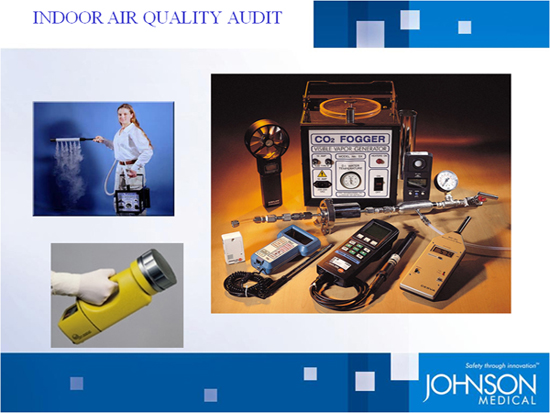|
|
| |
| |
Indoor Air Quality Audit
Indoor air quality (IAQ) is a term referring to the air quality within and around buildings and structures, especially as it relates to the health and comfort of building occupants.
IAQ can be affected by microbial contaminants (mold, bacteria), gases (including carbon monoxide, radon, volatile organic compounds), particulates, or any mass or energy stressor that can induce adverse health conditions. Indoor air is becoming an increasingly more concerning health hazard than outdoor air. Using ventilation to dilute contaminants, filtration, and source control are the primary methods for improving indoor air quality in most buildings.
Determination of IAQ involves the collection of air samples, monitoring human exposure to pollutants, collection of samples on building surfaces and computer modelling of air flow inside buildings.
* excerpt from Wikipedia http://en.wikipedia.org/wiki/Indoor_air_quality
Healthcare facilities, such as hospitals, have to pay particular care to indoor air concerns. Many of those who are susceptible to these problems may be patients such as people with pre-existing health problems, the frail elderly, people with cancer who are going through treatment, and those who may have depressed immune systems. Some hospitals also have special units that need particular care in terms of indoor air quality such as bone marrow units, neonatal intensive care units, and burn units. In addition to having people inside the building who are at risk to these problems, there are some unique indoor air concerns in healthcare facilities including those usually found in buildings. These include:
- Infectious diseases and other biological hazards
- Chemical hazards
- Unique ventilation requirements
Infectious Diseases and Other Biological Hazards
Biological contaminants such as bacteria, mold, and viruses can breed in stagnant water that has gradually accumulated in ducts, humidifiers and drain pans of the ventilation system; or water that has collected on ceiling tiles, carpeting, or insulation. This is particularly a problem in older buildings that may have broken fans or other maintenance problems... Read more
* Taken from www.inspiredliving.com
|
| |
 |
| |
|
|
|

